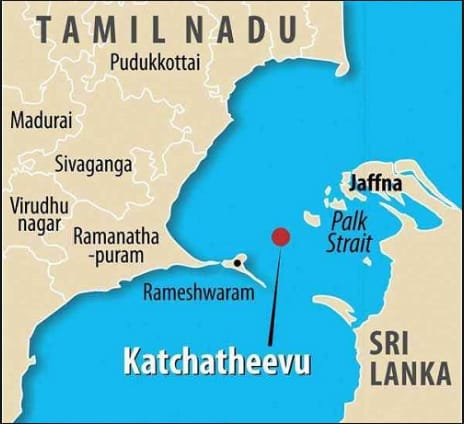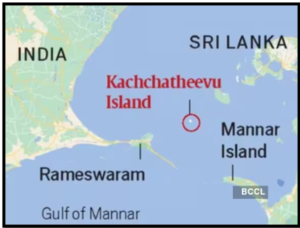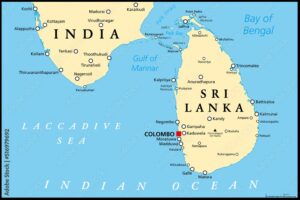KATCHATHEEVU ISLAND AND THE ISSUE
Syllabus:
- GS-1: World History ,Major underpinnings in the post independent India
- GS-2 : India and the neighbourhood.
Focus:
- Prime Minister Narendra Modi’s ‘X’ post has rekindled the issue of ‘ceding’ Katchatheevu Island to Sri Lanka in 1974, also an issue in which INDIA bloc allies Congress, DMK and MDMK are not on the same page.
- About one-and-a-half months ago, Katchatheevu was in limelightas, in late February, fishermen associations in Ramanathapuram district boycotted the annual two-day festival, as a mark of protest against the Sri Lankan Government’s continuing arrests of Indian fishermen on charges of poaching.
Katchtheevu Island :
- The Palk Strait has the island of Katchatheevu. It is situated between Sri Lanka’s Neduntheevu and Tamil Nadu’s Rameswaram. Under Sri Lankan governance, it is an uninhabited It covers an area of roughly 1.15 square kilometers.
History of the Island :
- The island was initially known as Kacci, mentioned in the Rameswaram Inscription of King Nissanka Malla of Sri Lanka.
- Historical evidence suggests its jurisdiction under Sri Lanka since the Portuguese, Dutch, and British eras.
- During the medieval period, it was part of the Jaffna kingdom and later the Ramnad Kingdom(Tamil Nadu) under British rule.
- Dispute emerged between Indian and Sri Lankan colonial governments in 1920, with India claiming ownership based on a landlord’s association with the Raja of Ramnad.
- Horsburgh opposed India’s claim, asserting the island’s association with the Jaffna Diocese.
- By 1921, a border agreement placed the island within Sri Lankan territory.The dispute persisted until 1974, with India recognizing Sri Lanka’s ownership that year.
1974 India-Srilanka Agreement:
- Ownership of Katchatheevu changed when Prime Ministers Indira Gandhi of India and Sirima R.D. Bandaranaike of Sri Lanka signed an agreement in 1974 acknowledging the island as part of Sri Lanka.
- Additionally, the deal permitted Indian pilgrims to visit the island’s Catholic shrine and allowed fisherman from that region to fish around the island and dry their nets there.
- The governments of India and Sri Lanka have an agreement that states that Indian nationals visiting Kachchatheevu do not need to have a Sri Lankan visa or an Indian passport.
- The transfer’s legality was challenged in the Indian Supreme Court due to lack of ratification by the Indian Parliament.
1976 Supplemental Agreement
- In addition to placing limits on fishing boats and fishermen from either country—fishing in each other’s waters without express permission from either—the 1976 agreement also attempted to define maritime borders and exclusive economic zones for both nations.
Political Agitations and Cultural Significance:
- Tamil Nadu politicians have protested the recognition, advocating for Indian sovereignty over the culturally significant island.
- The island holds importance for Tamil Nadu fishermen and serves as a fishing ground shared by both countries.
- The Indo-Sri Lankan agreement permits Indian fishermen’s access to the island for fishing activities.
| Environmental significance of the area:
· The Gulf of Mannar and Palk Bay form a transboundary area within the waters off India and Sri Lanka. A remnant but still breeding population of dugongs (Dugong dugon) · Gulf of Mannar marine national park: Spread across an area of 560 sq.kms., the biosphere covers the coasts of Thoothukudi, Tirunelveli, Rameswaram and Kanyakumari. · Gulf of mannar biosphere reserve : The Gulf of Mannar endowed with three distinct Coastal ecosystems namely coral reef, seagrass bed and mangroves |
| Adam’s Bridge
· Location: The Ram Setu, also known as Adam’s Bridge and Nala Setu, spans 48 kilometers and lies between Rameswaram on India’s southeast coast and Mannar Island near Sri Lanka’s northwest coast. · Nature of the Bridge: Scientists attribute the formation of Ram Setu to natural processes, including tectonic movements and the accumulation of sand in corals. However, some contend it to be man-made, citing evidence over time. · Geological Theories: Geological studies suggest that Sri Lanka was once connected to the Indian landmass, with calcareous blocks indicating a separation around 125,000 years ago. · Religious Beliefs: According to Hindu tradition, the bridge was constructed by Lord Ram and his army to reach Lanka and confront Ravan. Conversely, Islamic lore suggests that Adam used the bridge to access Adam’s Peak in Sri Lanka. Palk Strait : · The Palk Strait separates the island nation of Sri Lanka’s Northern Province’s Jaffna District from the Indian state of Tamil Nadu. · It links Palk Bay in the southwest with the Bay of Bengal in the northeast. · Robert Palk, a governor of Madras (1755–1763) during the Company Raj era, is honored by the strait’s name. St Antony’s festival : · A Catholic church called St. Antony’s Shrine is situated on Sri Lanka’s Katchatheevu Island. On the island, it is the lone building. constructed. Every year, festival is organized . |
Indian Government’s Position:
- The Indian government’s stance in 2013 clarified that no Indian territory was relinquished, thus rejecting the notion of retrieval of Katchatheevu.
- It framed the issue as a historical dispute between British India and Ceylon (now Sri Lanka), emphasizing the resolution through agreements in 1974 and 1976.
- The Union government asserted that Katchatheevu is situated within the territory of Sri Lanka, as per the India-Sri Lanka International Maritime Boundary Line.
Source:
- Indian Express
- The Hindu
Mains Practice Question :
GS-1
- “Discuss the historical evolution and legal intricacies of the Katchatheevu dispute between India and Sri Lanka. How did colonial legacies and bilateral agreements shape the sovereignty claims over the island?(250words)
- Analyze the implications of the 1974 and 1976 agreements in resolving the territorial issue, and assess the contemporary significance of the dispute in the context of maritime boundaries and geopolitical dynamics in the Indian Ocean region.”(250 words)
GS2
- Examine the Katchatheevu dispute in the context of India’s relations with its neighboring countries.(250 words)






